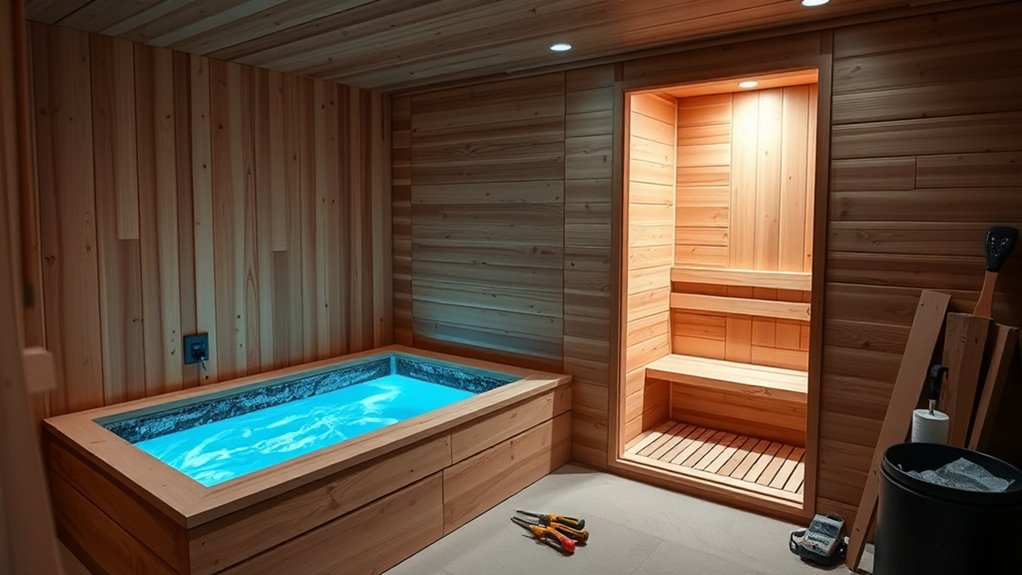To build a home sauna for cold-plunge therapy, select durable, heat-resistant materials like cedar and incorporate infrared heating for efficient, gentle warmth. Guarantee proper ventilation with intake and exhaust vents for safety and airflow, and add quality insulation to maintain consistent temperatures. Keep controls simple for ease of use and include enough space for a cold plunge area. If you keep exploring, you’ll discover detailed steps to create a comfortable, safe, and effective wellness space.
Key Takeaways
- Incorporate infrared heaters with adjustable settings for personalized, gentle warmth during sauna sessions.
- Use non-porous, heat-resistant materials like cedar for durability and effective heat retention.
- Install proper ventilation with intake vents near the floor and exhaust vents higher up to ensure airflow and reduce humidity.
- Insulate the sauna thoroughly with moisture-resistant materials to maintain consistent temperature and improve energy efficiency.
- Design an accessible layout with simple controls for ease of use and maintenance, supporting cold-plunge integration.

If you’re looking to enhance your recovery routine, building a home sauna for cold-plunge therapy can be a game-changer. One of the key aspects to think about is how the sauna will generate heat. Infrared heating is an excellent option because it heats your body directly without warming the surrounding air as much, allowing for a more comfortable experience and quicker sessions. Infrared panels are easy to install and energy-efficient, making them a practical choice for a home setup. They also provide a gentle, penetrating warmth that promotes relaxation and detoxification, which complements the invigorating shock of cold plunges. When choosing infrared heaters, make sure they have adjustable settings so you can customize the intensity based on your preference and recovery needs. Additionally, selecting the right sauna materials can improve heat retention and durability over time.
Infrared heating offers comfortable, direct warmth with energy efficiency, perfect for enhancing your home sauna experience.
Another critical component is sauna ventilation. Proper airflow is essential for maintaining a safe, comfortable environment and ensuring the longevity of your sauna. Good ventilation helps regulate temperature, prevent excess humidity, and reduce the buildup of stale air that can cause discomfort or mold growth. You’ll want to install intake and exhaust vents strategically—ideally, intake vents near the floor and exhaust vents higher up—to promote continuous air circulation. This airflow not only keeps the space fresh but also helps control the temperature when you’re switching between hot sauna sessions and cold plunges. Adequate ventilation also contributes to energy efficiency, as it prevents overheating and reduces the workload on your infrared heaters.
Building your sauna with the right insulation and ventilation also means considering the materials you use. Choose non-porous, heat-resistant materials like cedar or other high-quality woods that withstand moisture and temperature changes. Proper insulation ensures that heat stays inside, making your infrared heating setup more effective and energy-efficient. Combined with good ventilation, insulation creates a stable environment that makes each session more comfortable and productive.
Finally, don’t forget that the overall design should facilitate ease of use. Incorporate a simple control system for your infrared heaters, and plan for easy access to the ventilation points. Proper planning during construction ensures that your sauna functions efficiently and safely, providing an ideal space for cold-plunge therapy. When you combine infrared heating with thoughtful sauna ventilation, you create a space that’s both effective for recovery and enjoyable to use—one that elevates your wellness routine to the next level.
Frequently Asked Questions
What Are the Best Materials for Insulation in a Home Sauna?
You should choose insulation types like mineral wool, foam board, or spray foam to maximize thermal efficiency in your sauna. These materials effectively trap heat, ensuring your sauna stays warm and energy-efficient. Mineral wool is fire-resistant and soundproof, while foam boards provide high R-value. Spray foam offers seamless insulation, reducing air leaks. Selecting the right insulation enhances comfort and energy savings, making your sauna more enjoyable and efficient.
How Do I Ensure Proper Ventilation in My Sauna?
Think of your sauna as a well-tuned orchestra, where ventilation fans play the role of skilled conductors. To guarantee proper ventilation, install effective ventilation fans and design air circulation paths that promote fresh airflow. Keep vents unobstructed and consider adding a small window or vent for natural air exchange. Proper air circulation prevents moisture buildup, maintains a healthy environment, and keeps your sauna comfortable and safe.
What Safety Precautions Should I Take During Installation?
You should prioritize electrical wiring safety by hiring a licensed professional to handle connections, ensuring all wiring meets local codes. Install smoke detectors and fire extinguishers nearby for fire safety. Keep the sauna well-ventilated during installation, and avoid overloading circuits. Use proper grounding and moisture-resistant materials. Always double-check all electrical components before use, and follow manufacturer instructions carefully to minimize risks.
How Often Should I Maintain and Clean the Sauna?
You should clean and maintain your sauna regularly, ideally after every use, to guarantee safety and hygiene. Follow a consistent maintenance schedule, including wiping down surfaces, checking for mold or mildew, and inspecting electrical components. Prioritize sauna cleaning by removing sweat and debris, and perform deep cleans monthly. This routine keeps your sauna safe, functional, and inviting, so you can enjoy cold-plunge therapy without worry.
Can I Incorporate Smart Technology Into My Sauna Design?
Yes, you can definitely incorporate smart technology into your sauna design. With smart temperature controls and app control, you can easily adjust settings remotely, ensuring your sauna is perfect before you even step inside. This technology allows you to customize your experience, monitor temperature levels, and even set timers, making your cold-plunge therapy more convenient and efficient. Upgrading to smart features enhances comfort and control during your wellness routine.
Conclusion
Creating your own home sauna for cold-plunge therapy is a rewarding project that can boost your health and relaxation. Some might think it’s too complicated or costly, but with careful planning and DIY effort, it’s achievable. Remember, the benefits of consistent cold therapy—improved circulation, reduced stress—are well worth the effort. Start small, learn as you go, and enjoy the long-term wellness gains. Your personalized sauna can become a sanctuary for rejuvenation and resilience.







